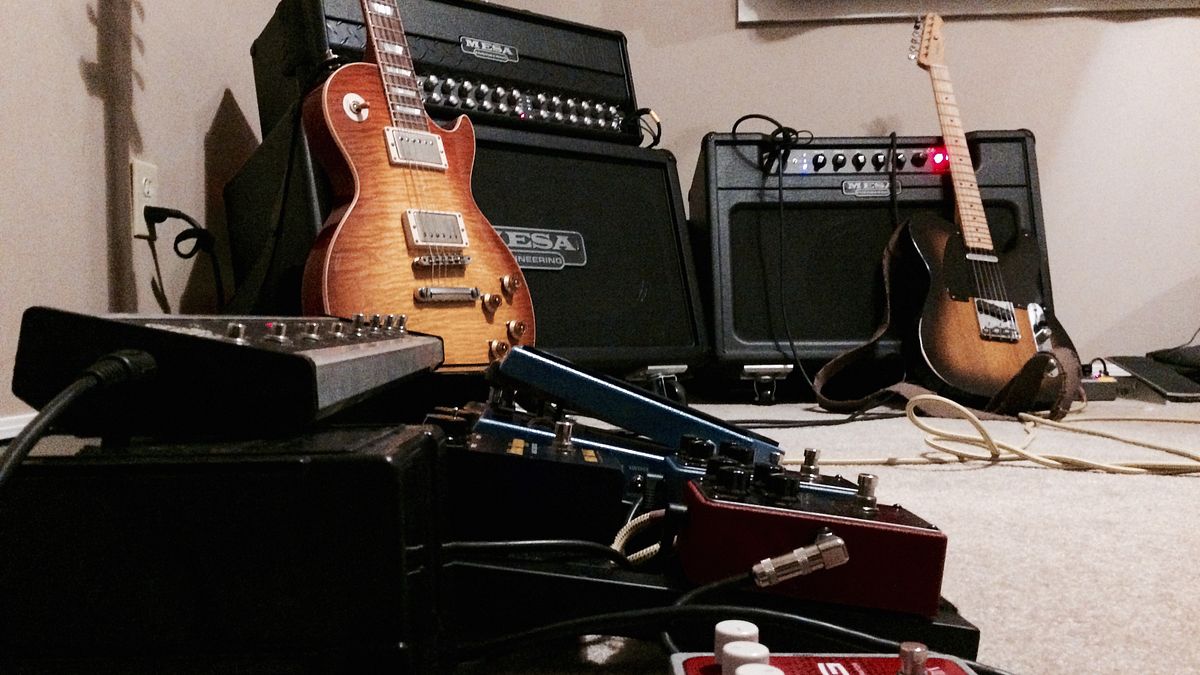screamingdaisy said:
Random thought... the Roadster slaved into my 2 channel Recto is an effective stereo setup. Cost $0. Buying a second 2x12 will give me the same basic setup plan B, only with two heads/cabs instead of a combo.
Another random thought... I wonder how the pairing of a 6L6 amp and EL84 amp will sound in stereo vs a pair of 6L6 amps... ?
This is basically what I am doing: I have a Tremoverb 2x12 combo and a Multi-Watt Dual Rectifier set up as a stereo rig.
Super basic stereo rig:
You make this happen by taking the fx send of one amp and splitting the signal so that it gets fed into the fx returns of both amps. I used a stereo flanger pedal for this (I never actually turned on the flange, effect, it just made a good ad hoc splitter box.
This setup basically slaves both power amps to which ever preamp you've made master. So if you know you always want the Roadster to generate your tones, this is simple. There's no reason not to use other stereo effects in the loop.
The only con of this configuration is that rewiring it is a pain in the butt. If you want to use the 2 channel recto to drive the system or want to run the in parallel instead of stereo you're going to have to get behind the amps to decide what is plugged into what.
Less basic stereo rig:
Get an A/B/Y cable and plug the fx send of the Roadster in the A input and the fx send of the 2 channel recto into the B input. Use the pedal to toggle which one drives you stereo fx loop.
Now you can drive your stereo rig with the Roadster -or- the 2 channel rectfier. I used this setup with both amps for a long time.
Current setup
I picked up a Boss ES-8 switcher, and got this setup working with both of my amps, then I added a Mark V:25 head as well and switch between all three amps, including channel switching.
The configuration is a little more exotic, but the ES-8 was designed to allow you to switch in or out multiple pedal loops in different ordres. This normally looks like:
Loop 1: ES-8 loop 1 output -> pedal 1 input, pedal 1 output -> ES-8 loop 1 input
Loop 2: ES-8 loop 2 output -> pedal 2 input, pedal 2 output -> ES-8 loop 2 input
I decided to put a couple of amps in those two spots instead of pedals:
Loop 1: ES-8 loop 1 output -> Roadster guitar input, Roadster fx send -> ES-8 loop 1 input
Loop 2: ES-8 loop 2 output -> 2 channel recto guitar input, 2 channel recto fx send -> ES-8 loop 2 input
Mixing and matching
With the a/b/y setup I used to have configurations where I wanted both amps running in parallel, like Kim Thayil does. I had footcontrollers for my Road King II, my full sized Mark V, and the A/B/Y switch and would pedal dance like crazy to get things working.
To do both amps in parallel I'd just turn off the fx loops of each amp.
I have some notes about using my Electra Dyne in these configurations and can get to that later.
I hope some of this was useful. I have a photo of my own current rig, using my Tremoverb, my Dual Rectifier, and my Mark V:25 head here https://flic.kr/p/ACVEG9. I use the ES-8 to control which amp is driving the two speaker cabinets and handling switching, and can basically select any one of the following in a single click:
1. Mark V Channel 1
2. Mark V Channel 2
3. Tremoverb Channel 1
4. Tremoverb Channel 2
5. Dual Rectifier Channel 1
6. Dual Rectifier Channel 2
7. Dual Rectifier Channel 3
It's great for recording.
-Daniel








